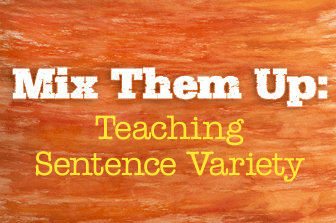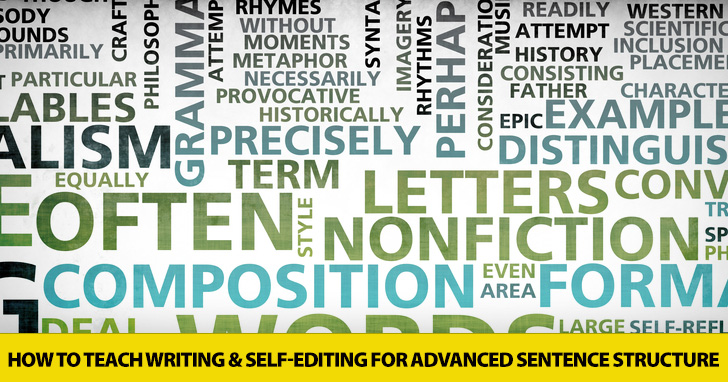Mix Them Up: Teaching Sentence Variety


Academic writing has different word choices related to more complex, academic, and technical texts, for example. The patterns of organization between the conversational and academic are also different, with conversational patterns tending to reflect more narrative structures: for example, in answering the question “How was your day?” I would respond with a narrative of the day’s events or one event (if I said anything beyond “fine,” that is). Academic organization of texts reflects more cause-effect, persuasive, or expository structures, often combined in one text. And related to this different organization is the sentence structure. In conversation, in relating a day’s events, I would in all likelihood respond with short, simple sentence structures that I would be able to construct in an “online” extemporaneous situation and that my listener can easily process. “I went to the store to buy bread. I met Sally while I was there. We started to talk about this weekend…” etc. Simpler narrative written texts also reflect this structure. “I have experienced many life lessons. One important life lesson sticks with me. I learned it is important to keep promises …” and so forth. The vocabulary and sentence structure is kept simple reflecting the relative simplicity of this task. Traditionally, sentence structure variety has been taught by teaching students to combine some of these sentences: “I have experienced many life lessons, but one important life lesson…” etc. And while this is a start, it does not reach the level of complex sentence structure needed to understand complex technical written texts, write at a more scholarly or technical level, or participate in an academic discussion. There are actually a number of methods an instructor can use to help students in reading and writing academic sentence structure.

Again, a simpler narrative topic such as “A Life Lesson” will naturally suggest a narrative response as students recount in conversational language and sentence structure the lesson learned. A topic such as “Reasons for the Decline of the Telegraph” or “What Plagiarism is and How It Should be Treated in the Age of the Internet” requires reading on the topic, which will model more complex sentence structures as well as producing more academic vocabulary in response to the reading.
Another important method is to expose students to complex sentence structures, and this will be through more academic/technical reading. If students are reading narrative structure, mostly, found in short stories, autobiographies, and novels, they will be exposed to the mostly narrative structure and simpler sentence patterns generally found in those texts. If students are reading more academic texts on social issues and in the academic disciplines such as science and history, they are more likely to be exposed to more complex sentence structures with various kinds of dependent clauses, passive verb structures, longer sentences with a variety of clauses and phrases, and so forth. It is not enough to just read and be exposed to more complex sentence structures in order to write it, but it is a necessary first step.
More advanced, technical vocabulary will likely require more advanced sentence structure. In response to the topic of “cheating,” for example, a student will mostly likely discuss a time she cheated as a young girl before she really understood what it was, a near-universal experience, and she is back to using familiar simpler sentence patterns in discussing this event. If, however, the assignment is on the more academic and specialized topic of plagiarism—a specific kind of academic cheating, of stealing someone else’s written words—why people do it, and what its effects are, the assignment is taken out of the personal narrative and into a more complex, analytical structure. This structure will require use of grammatical forms such as dependent clauses, passive voice constructions, transitional phrases that demonstrate connections between ideas, and so forth.
Another method to demonstrate writing academic, complex sentences is to use current student work or past student work—anonymously, with student permission, of course.
A short paragraph of the student’s work can be shown on a projector, and the instructor can model different, more effective ways to combine sentences, create transitions between ideas, vary sentence structures, and so forth. Students can then work together in groups, revising the rest of the paper for sentence structure.
Once students have some idea of how to form advanced sentence structures through analyzing and editing other’s work, they have enough understanding to apply the strategies to their own work. They can look at the typical problems they have in their work, such as run-on sentences or fragments, or too many simple sentences, and consider how to better combine sentences. They can use other techniques such as reading their own work out loud and considering what needs to be changed. They can challenge themselves to go beyond simple sentences and make a conscious effort to include more dependent clauses and introductory phrase or they can be required to do so as part of the assignment.
Writing and self-editing advanced sentence structure is difficult, requiring knowledge of complex sentence structures, how to write them, and then how to edit one’s own work. However, through some strategies such as teaching complex sentence patterns, analyzing examples, assigning academic topics for writing, and teaching editing skills, students will be able to produce grammatically sound papers with academic vocabulary and grammar.